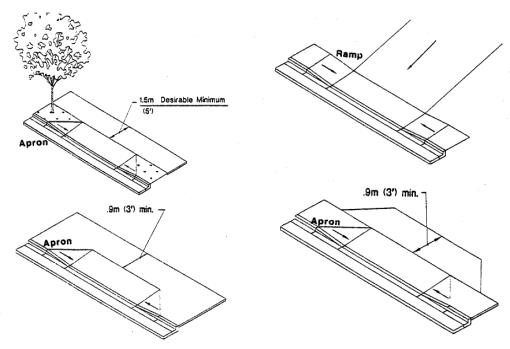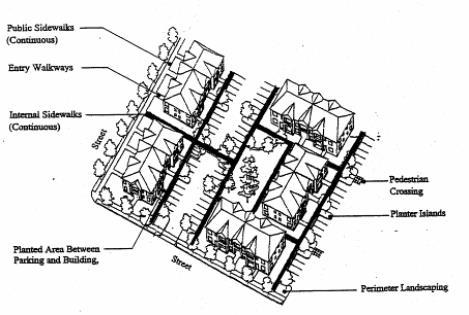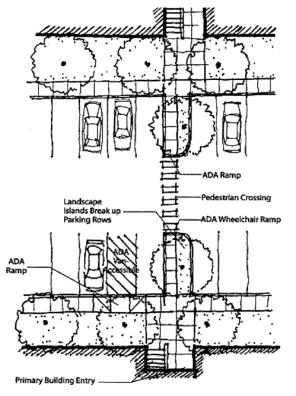Chapter 3.1 –
Access and Circulation
Sections:
3.1.300 Vehicular Access and Circulation
3.1.400 Pedestrian/Bicyclist Access and Circulation
3.1.100 Purpose
The purpose of this Chapter is to ensure that developments provide safe and efficient access and circulation for pedestrians, bicycles (including ADA and transit accessibility) and motorized vehicles including emergency vehicles and to preserve the transportation system in terms of safety, capacity, and function.
3.1.200 Applicability
A. Applicability. This Chapter applies to all rights-of-way within the City and to all properties that abut these rights-of-way. The standards apply when lots are created, consolidated, or modified through a land division, partition, or street vacation; and when properties are subject to Site Plan Review. These standards also may be applied at the City’s discretion during Conditional Use permit.
3.1.300 Vehicular Access and Circulation
A. Traffic Study and Control Requirements
1. The City or other agency with access jurisdiction may require a traffic study prepared at applicant/developers expense by a qualified professional to determine access, circulation and other transportation requirements. A Traffic Impact Study shall be required for all development applications that will result in a traffic impact or increase in traffic impact of 200 or more average daily trips (ADT).
2. Traffic control devices, subject to the approval of the Hearings Body, shall be required with development when traffic signal warrants are met, in conformance with the Oregon State Highway Capacity Manual, and Manual of Uniform Traffic Control Devices. The location of traffic control devices shall be noted on approved street plans. Where a proposed street intersection will result in an immediate need for a traffic signal or other traffic control device, a device meeting approved specifications shall be installed. The developer’s cost and the timing of improvements shall be included as a condition of development approval.
3. Traffic-calming features, such as curb extensions, narrow residential streets, and special paving shall be required where appropriate and in accordance with the Transportation System Plan and Public Works’ Standards and Specifications, latest edition, in order to slow traffic in neighborhoods and areas with high pedestrian traffic and to maximize a pedestrian friendly environment.
B. Access Management. The City or other agency with access permit jurisdiction may require the closing or consolidation of existing curb cuts or other vehicle access points, recording of reciprocal access easements (i.e., for shared driveways), development of a frontage street, installation of traffic control devices, and/or other mitigation as a condition of granting an access permit, to ensure the safe and efficient operation of the street and highway system
C. Fire Access and Turnarounds. When required under the Oregon Fire Code, fire access lanes with turnarounds shall be provided. Except as waived in writing by the Fire Marshal, a fire equipment access drive shall be provided for any portion of an exterior wall of the first story of a building that is located more than 150 feet from an existing public street or approved fire equipment access drive. The drive shall contain unobstructed adequate aisle width (20 feet) and turn-around area for emergency vehicles. The Fire Marshal may require that fire lanes be marked as “No Stopping/No Parking.”
D. Vertical Clearances. Except for drive-through windows, all driveways, private streets, aisles, turn-around areas and ramps shall have a minimum vertical clearance of 13' 6" for their entire length and width.
E. Vision Clearance. Visual obstructions between three (3) feet and eight (8) feet in height are subject to Special Provisions, Vision Clearance.
F. Surface Options. All provided driveway, aprons, parking areas, aisles, and turn-arounds shall be paved with asphalt, concrete or comparable durable surfacing, subject to review and approval by the Community Development Director. Properties located in the Light Industrial (LI) District shall refer to Chapter 2.6.
G. Surface Water Management. All driveways, parking areas, aisles and turn-arounds shall have on-site collection or infiltration of surface waters to eliminate sheet flow of such waters onto public rights-of-way and abutting property. Surface water facilities shall be constructed in conformance with City standards. Swales may be considered to control surface water.
H. Private Streets and Alleys. Public and private streets and alleys shall conform to the standards in the City of Sisters Public Works Construction Standards, latest edition. While alley intersections and sharp changes in alignment shall be avoided, the corners of necessary alley intersections shall have a radius of not less than 20 feet.
I. Access Standards
1. Access spacing standards. Street intersection and driveway spacing shall comply with the table below (Figure 3.1.300.A):
|
Street Facility |
Maximum spacing* of roadways |
Minimum spacing* of roadways |
Minimum spacing* of roadway to driveway |
Minimum Spacing* driveway to driveway |
|---|---|---|---|---|
|
Arterial |
1,000 feet |
660 feet |
330 feet |
330 feet or combine |
|
Collector: |
600 feet |
330 feet |
100 feet |
100 feet or combine |
|
Neighborhood/ |
600 feet |
150 feet |
50 feet |
10 feet |
Notes: *Measured centerline to centerline
TSP January 2010
2. Properties with Multiple Frontages. Where a property has frontage on more than one street, access shall be limited to the street with lesser classification.
3. Alley Access. If a property has access to an alley or lane, direct access to a public street is not permitted.
4. Closure of Existing Accesses. Existing accesses that are not used as part of development or redevelopment of a property shall be closed and replaced with curbing, sidewalks/pathways, and landscaping, as appropriate.
5. Shared Driveways on Arterial Streets. The number of driveways onto arterial streets shall be minimized by the use of shared driveways with adjoining lots where feasible. The City shall require shared driveways as a condition of land division or Site Plan Review, as applicable, for traffic safety and access management purposes in accordance with the following standards:
a. Where there is an abutting developable property, a shared driveway shall be provided. When shared driveways are required, they shall be stubbed to adjacent developable parcels to indicate future extension. “Stub” means that a driveway temporarily ends at the property line, but may be accessed or extended in the future as the adjacent parcel develops. “Developable” means that a parcel is either vacant or it is likely to receive additional development (i.e., due to infill or redevelopment potential).
b. Access easements (i.e., for the benefit of affected properties) shall be recorded for all shared driveways, including pathways, at the time of final plat approval or as a condition of site development approval.
c. No more than two lots may access one shared driveway.
6. Frontage Streets and Alleys. The decision maker for Site Plan Review or subdivision may require construction of a frontage street or alley to provide access to properties fronting an arterial or collector street.
7. Exceptions
a. The Community Development Director or designee may allow exceptions to the access standards above in any of the following circumstances:
1. Where existing and planned future development patterns or physical constraints, such as topography, parcel configuration, and similar conditions, prevent access in accordance with the above standards.
2. Where the proposal is to relocate an existing access for existing development, where the relocated access is closer to conformance with the standards above and does not increase the type or volume of access.
3. Where the proposed access results in safer access, less congestion, a better level of service, and more functional circulation, both on-street and on-site, than access otherwise allowed under these standards.
4. When access requirements are divided by one or more multi-use pathway(s), in conformance with the provisions of Section 3.1.400. Multi-use pathways shall be located to minimize out-of-direction travel by pedestrians and bicycles and shall be 10-feet wide and located within an easement whose width is specified by the Fire Marshal.
b. Where an exception is approved, the access shall be as safe and functional as practical in the particular circumstance. The City may allow construction of an access connection at a distance less than required from an intersection, provided the access is as far away from the intersection as possible. In such cases, the City may impose turning restrictions (i.e., right in/out, right in only, or right out only) and may also require that the applicant submit a traffic study by a registered engineer to show the proposed access meets these criteria.
8. Access Management Plan. In addition, all requests for an access spacing exception shall be required to complete an access management plan for review and approval by the Public Works Director or City Engineer, which should include at a minimum the following items:
a. Review of the existing access conditions within the study area (defined the property frontage plus the distance of the minimum access spacing requirement). This should include a review of the last three years of crash data, as well as collection of traffic volume information and intersection operations analysis.
b. An analysis of the study area safety and operations with the proposed access configuration, as well as with a configuration that would meet access spacing standards. This scenario should also include consideration of the long-term redevelopment potential of the area and discussion of how access spacing standards may be achieved.
J. Driveways, Access Connections and Driveway Design
1. Driveway Openings. Driveway openings (or curb cuts) shall be the minimum width necessary to provide the required number of vehicle travel lanes (10 feet minimum width for each travel lane). The following standards are required to provide adequate site access, minimize surface water runoff, and avoid conflicts between vehicles and pedestrians (as measured where the front property line meets the sidewalk or right-of-way):
a. Single family, two-family, and three-family residential uses shall have a minimum driveway opening width of 10 feet, and a maximum width of 24 feet. Wider driveways may be necessary to accommodate approved paved recreational vehicle pads, but the driveway opening or connection to the street shall not be allowed to be wider.
b. Multi-family developments shall have a minimum driveway opening width of 20 feet, and a maximum width of 26 feet. These dimensions may be increased subject to the City Engineer approval.
c. Other Uses. Access widths for all other uses shall be based on 10 feet of width for every travel lane. These dimensions may be increased subject to the City Engineer approval. Driveways providing direct access to parking spaces shall conform to the parking area standards in Chapter 3.3, Vehicle and Bicycle Parking. Properties located in the Light Industrial (LI) District shall refer to Chapter 2.6.
2. Driveway Approaches. Driveway approaches shall be designed and located to provide exiting vehicles with an unobstructed view of other vehicles and pedestrians, and to prevent vehicles from backing into the flow of traffic on the public street or causing conflicts with on-site circulation. Construction of driveway accesses along acceleration or deceleration lanes or tapers should be avoided due to the potential for vehicular conflicts. Driveways should be located to allow for safe maneuvering in and around loading areas.
3. Driveway Construction. Driveway aprons (when required) shall be installed between the street right-of-way and the private drive, as shown in Figure 3.1.300.B. Driveway aprons shall conform to ADA requirements for sidewalks and pathways,
Figure 3.1.300 B
K. No development may occur unless required public facilities are in place or are guaranteed in conformance with the provisions of this Code. Improvements required as a condition of development approval, when not voluntarily accepted by the applicant, shall be roughly proportional to the impact of development. Findings in the development approval shall indicate how the required improvements are roughly proportional to the impact. All public improvements shall be in conformance with the City of Sisters Public Works Construction Standards, latest edition. [Ord. 533 § 3 (Exh. K), 2023].
3.1.400 Pedestrian/Bicyclist Access and Circulation
A. Site Layout and Design. To ensure safe, direct, and convenient pedestrian circulation, all developments shall provide a continuous pedestrian system. The pedestrian system shall be based on the standards in subsections 1-3, below:
1. Continuous Access and Circulation System. The pedestrian/bicycle circulation system shall extend throughout the development site and connect to all future phases of development, and to existing or planned off-site adjacent trails, public parks, and open space areas to the greatest extent practicable. The developer may also be required to connect or stub pathways or multi-use paths to adjacent streets and to private property with a previously reserved public access easement for this purpose.
2. Safe, Direct, and Convenient. Pathways and multi-use paths within developments shall provide safe, reasonably direct, and convenient connections between primary building entrances and all adjacent streets
3. Pathway Connections within Development. Connections within developments shall conform to the following standards:
a. Pathways shall connect all building entrances to one another to the extent feasible;
b. Pathways shall connect all on-site parking areas, storage areas, recreational facilities and common areas, and shall connect off-site adjacent uses to the site to the extent feasible. Topographic or existing development constraints may be cause for not making certain pathway connections, as generally shown in Figure 3.1.400.A; and
Figure 3.1.400.A Pedestrian Pathway System (Typical)
B. Pathways Design and Construction. Pathways and multi-use paths shall conform to the following standards:
1. Vehicle/Pathway and Multi-use Path Separation. Except for crosswalks (subsection 2) and for properties in the Light Industrial Zone, where a pathway or multi-use path abuts a driveway or street, it shall be raised 6 inches and curbed along the edge of the driveway/street. Alternatively, the decision body may approve a pathway or multi-use path abutting a driveway at the same grade as the driveway if the pathway or multi-use path is protected from all vehicle maneuvering areas. An example of such protection is a row of decorative metal or concrete bollards designed to withstand a vehicle’s impact, with adequate minimum spacing between them to protect pedestrians and bicyclists.
Figure 3.1.400 Crosswalk Detail (Typical)
2. Crosswalks. Where pathways and multi-use paths cross a parking area, driveway, or street (“crosswalk”), they shall be clearly marked with contrasting paving materials (e.g., light-color concrete inlay between asphalt), which may be part of a raised/hump crossing area. Painted or thermo-plastic striping and similar types of non-permanent applications may be approved for crosswalks not exceeding 24 feet in length.
3. Pathway and Multi-use Path Width and Surface.
Pathway surfaces shall be concrete, asphalt, brick/masonry pavers, or other durable surface, as approved by the Public Works Director or designee, at least 6 feet wide, and shall conform to ADA requirements. Multi-use paths (i.e., for bicycles and pedestrians) shall be the same materials, at least 10 feet wide and shall conform to ADA requirements.


